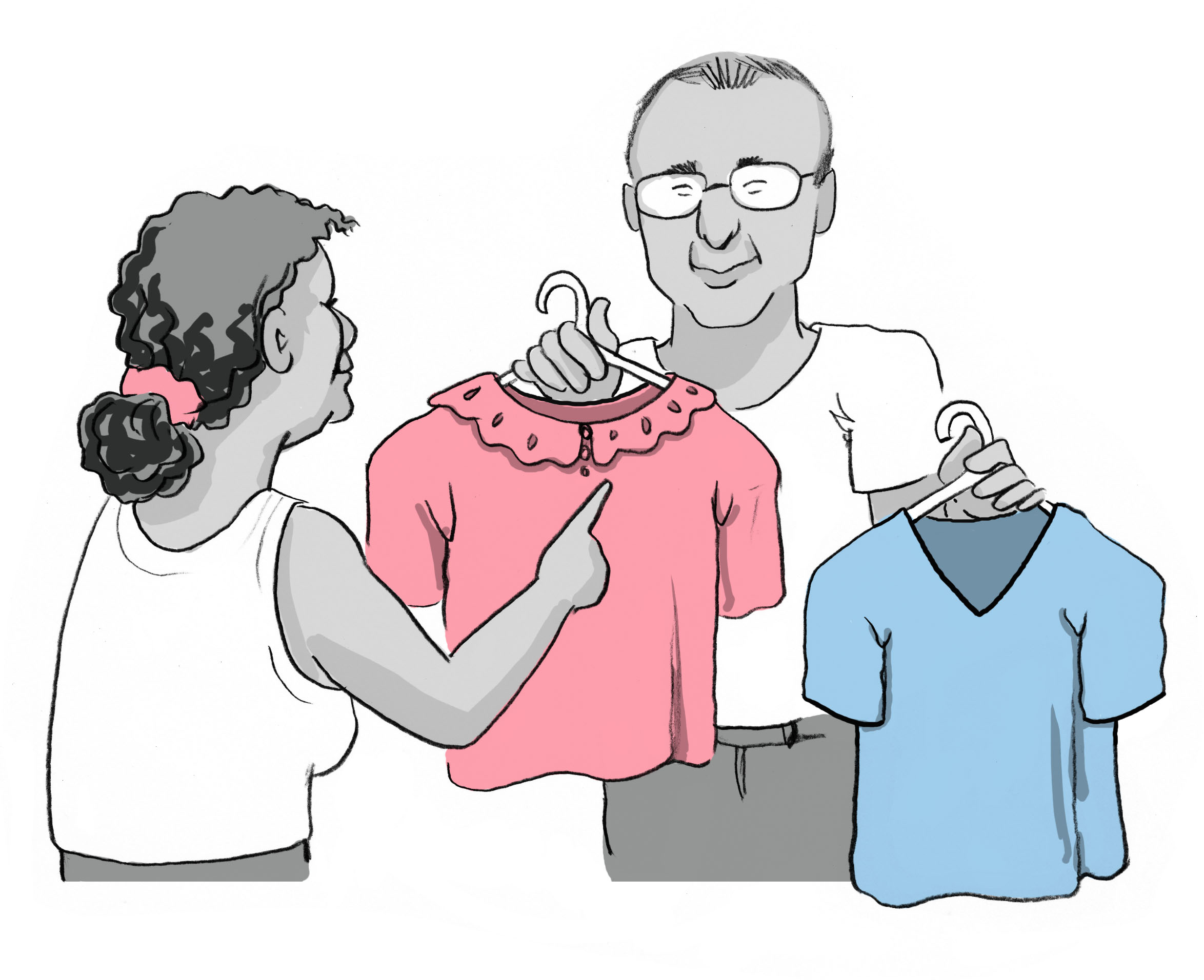The Power of Choice
 Give people every opportunity to make informed choices about their care, leisure time, clothing, food and anything else that affects their life.
Give people every opportunity to make informed choices about their care, leisure time, clothing, food and anything else that affects their life.
Moments We Relate To
Have you ever gone out to dinner with a person who is living with dementia? Did he or she have trouble making a choice from the menu? It is not uncommon for a person with dementia to order the very first item their eyes settle upon, or to just order whatever a companion orders. I’ve watched people order things I know they hate, because they can’t remember what that particular food is. It is hard to watch this happen. Choice is good, but it can also be overwhelming for someone with dementia. Try suggesting two items you know they like, so they have an opportunity to choose without being overwhelmed.
Sound familiar? Everyone goes through similar challenges, but the way we need to approach them may be different. Let’s get started finding your just right.
The Power of Choice
A Montessori environment has a variety of different activities and work sitting out on tables and shelves and encourages individuals to decide what to work on each day. Each person is encouraged to make their own choices. This provides structure, but also gives the person independence, self-esteem and the knowledge that they are respected.
Written by Jennifer Brush, MA, CCC/SLP
 People with dementia should be given every opportunity to make informed choices about their care, leisure time, clothing, food and anything else that affects their life. Providing choice will be done differently depending on the stage of dementia the person is in and any other accessibility issues that may be present.
People with dementia should be given every opportunity to make informed choices about their care, leisure time, clothing, food and anything else that affects their life. Providing choice will be done differently depending on the stage of dementia the person is in and any other accessibility issues that may be present.
Examples of Choice
On the following pages, we will go through examples of choices in different areas of the home and for different tasks. Each example will start off with the choice with the most options and will end with an example of the simplest choice. We hope these examples provide a jumping off point for you to look at any part of the day or any activity and think of a way to provide choice when you can. Everyone experiences dementia differently. You may need to try some of the ideas out and see what works best for you.
Most options:
Provide a closet of 10 selections of clothing for the week, plus options for specialty clothing like going to a fancy dinner or workout clothing. You can split up these sections with tags on the closet rod such as “Monday–Friday,” “Weekend,” “Workout,” etc.
Fewer options:
Limited selection of five days worth of work / weekday clothing options and two weekend wear options for them to choose from, and that is all that is in their closet every week.
Simplest options:
- Each day, lay out two outfit options on the bed and let the person choose one. (It is okay if they then mix and match within those two outfits.) OR
- Gather most items such as bottoms, underwear and socks, but then give a choice on one item, such as choosing between two shirts.
Meals
Most options:
Choose two breakfasts, three lunches and five dinners with simple recipes, and the person can make whichever recipe they want for each meal.
Fewer options:
At any given meal, provide them with a choice between two meal items such as eggs and toast or oatmeal for breakfast. If verbally telling them the options makes it difficult for them to decide, provide photos of each meal and let them point to and choose which meal they want.
Simplest options:
Provide a meal they like, but allow choice between two different drinks at each meal.
Cooking
Most options:
For snacks, create a labeled and contained “Snack Area” in the pantry and in the refrigerator. In a bin in the pantry and refrigerator, place three to five different snack items to choose from.
Fewer options:
In the “Snack Area,” provide photos of two to three items that make up a snack so the person can choose a card and match the items they need to the card.
Simplest options:
Choose a simple recipe and set up a work area with already measured ingredients and follow the pattern of putting one ingredient in a bowl, stirring, putting in the next ingredients, stirring, etc. until all ingredients are in, and the ingredients are stirred and ready to eat or bake.
Let the person decide how often to take a shower or a bath. If you are assisting in bathing, try to observe these rituals and provide choice based around their natural pattern of bathing. Some people may not want to bathe if we keep insisting that they must wash their hair first and they normally wash their body first.
Fewer options:
For timing of bathing, allow the person to choose the time as often as possible. If the person does not want to take a bath when you are asking them to, ask them if they would like to take a bath after dinner or before breakfast the next day. Write down, with them, the time they have chosen to bathe so you can refer to the decision again later.
Simplest option:
At shower and bathing times, provide choice between two different smelling soaps during the shower or two lotions after the shower.
Most options:
Weekly, go over scheduling of work and other events to learn more about what the person loves to do and how they want to spend their time to help them not over-schedule themselves and to be able to notice changes in the amount of events they can handle in a given day or week.
Fewer options:
Allow the person to coordinate their own day and check in with them on a larger calendar just to be sure they have logistics figured out and their events do not conflict with other events. Create activities that are around the home that the person can pick up and do at any time during the day. This provides choice throughout the day but with a limited number of choices that are prepared by the environment.
Simplest option:
Provide a general schedule, but each week or every few days, allow the person to choose between a few activities they would like to do, such as go out to a movie, shop at the farmer’s market, meet friends for coffee, etc.

Hang a small white board in the kitchen with one or two chores on it each day for the person with dementia. Remind the person at the same time each day to check the chore list.
Hand in Hand at Home
There are simple things you can do to transform your home into a supportive place that helps your loved one with dementia function better. We are going to show you just how to do it.
What is Dementia?
Dementia isn't a specific disease. Instead, dementia describes a group of symptoms affecting memory, thinking and social abilities severely enough to interfere with daily functioning.
Transforming Your Home
The best home environment is one that supports the abilities of the people living there.
Declutter
Understand the negative impact of clutter and take steps to improve the home environment.
Enhance Lighting
Simple changes in lighting can be made in the home to help your loved one function more independently and sleep better.
Support Memory
Create a memory center in your home to reduce confusion and foster wellbeing.
Communicate Effectively
Use a style of communication that is easier for the person with dementia to understand and follow conversations.
Understand Behaviors
Make sense of unexpected behaviors and learn how to prevent them.
Walking About
Tips for understanding and preventing walking about as well as information about how to choose a locating device.
The Power of Choice
Given them every opportunity to make informed choices about their care, leisure time, clothing, food and anything else that affects their life.
Power of Purpose
We all need a reason to get out of bed each day. People with dementia need to know their life has meaning and purpose.
Hiring Home Care
Learn how to ease the transition to additional care partners find out what questions to ask.
Self-Care
Advice for taking care of yourself, learning how and where to ask for help and scheduling breaks from caregiving.
Get Started!
You can do this! Take one step at a time. Follow these steps to get started.



